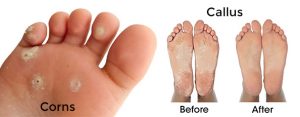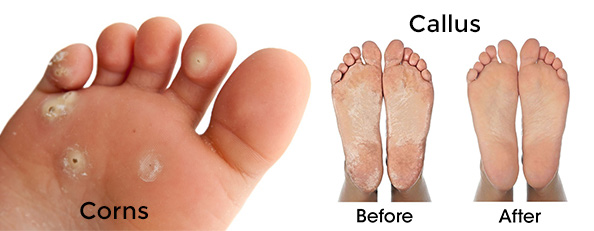 Our feet play an important role in keeping us mobile. When we walk or stand, our feet carry the burden of our body weight as well a bearing the various pressures of movement and constraints of our footwear. Sometimes pressure placed on the foot becomes out of balance and extra friction falls on a particular area of the foot. When this happens, the body may respond to the pressure by producing thickened areas of skin. These hard patches of skin are called calluses and are part of the body’s defence system to protect the underlying tissue. If the cause of the pressure is not relieved calluses can become painful.
Our feet play an important role in keeping us mobile. When we walk or stand, our feet carry the burden of our body weight as well a bearing the various pressures of movement and constraints of our footwear. Sometimes pressure placed on the foot becomes out of balance and extra friction falls on a particular area of the foot. When this happens, the body may respond to the pressure by producing thickened areas of skin. These hard patches of skin are called calluses and are part of the body’s defence system to protect the underlying tissue. If the cause of the pressure is not relieved calluses can become painful.
If the pressure becomes concentrated in a small area, a hard corn may develop. Sometimes the pressure of the corn or callus may produce inflammation which can result in acute pain, swelling and redness. Sometimes soft corns may form between the toes where skin is moist from sweat or inadequate drying. These appear white and rubbery, they can also be caused by excessive friction. Common sites of corns and calluses are the ball of the foot, under the big toe, tips of toes and any bony prominence. ‘Soft’ corns may develop between the toes, where the skin is moist from sweat or inadequate drying. Sometimes, the pressure of the corn or callus may produce inflammation, which can result in pain, swelling and redness.
Treatment
If you have corns or calluses, or think you may be developing them, see your podiatrist for treatment. Options may include:
- Identifying and removing the possible cause of friction and pressure
- Professional reduction of the callus or corn to relieve pain
- Customised padding to redistribute pressure
- If needed, permanent shoe inserts (orthoses) to offer long-term pressure relief
- Advice on appropriate footwear
- Advice on appropriate foot care, such as applying moisturiser daily.
It is important that you never cut corns or calluses yourself. In the warm, moist confines of enclosed shoes, infection can easily develop and small cuts can quickly become serious wounds.
Seek advice from your podiatrist regarding the most appropriate treatment for you.

